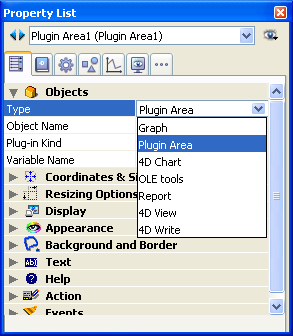4D v13.4
Plug-in areas
- 4D Design Reference
-
- Working with active objects
-
- What are active objects?
- Field and variable objects
- Buttons
- 3D Buttons, 3D Check Boxes and 3D Radio Buttons
- Picture Buttons
- Button Grids
- Check Boxes
- Radio Buttons and Picture Radio Buttons
- Pop-up Menus/Drop-down Lists
- Combo Boxes
- Hierarchical Pop-up Menus and Hierarchical Lists
- Picture Pop-up Menus
- Indicators
- Tab Controls
- Splitters
- Web areas
- Plug-in areas
 Plug-in areas
Plug-in areas
A plug-in area is an area on the form that is completely controlled by a 4D plug-in. When opening a database, 4D creates an internal list of the plug-ins installed in your database. Once you have inserted a Plug-in Area in a form, 4D lists the available plug-ins in the Property List window. By default, OLE tools (Windows only) and Report are available.
Note: Some plug-ins cannot be used in forms or external windows. When a plug-in cannot be used in a form, it does not appear in the plug-in list of the Property List.
To specify the plug-in to be used in the area, select its name directly in the Type list (“Objects” theme):

Note: When the object type chosen is Plugin Area, an Advanced button may be enabled if advanced options are provided by the author of the plug-in. In this case, you can click this button to set these options. Because the Advanced options dialog box is under the control of the author of the plug-in, information about these Advanced options is the responsibility of the distributor of the plug-in.
If you draw a plug-in area that is too small, 4D will display it as a button whose title is the name of the variable associated with the area. During execution, the user can click on this button in order to open a specific window displaying the plug-in.
To add a plug-in in your 4D environment, you first need to quit 4D. Plug-ins are loaded when you launch 4D. For more information about the installation of plug-ins, refer to Installing plugins or components.
The ability to incorporate plug-ins into forms gives you unlimited possibilities when creating custom applications. A plug-in can perform a simple task such as displaying a digital clock on a form, or a complex task such as providing full-featured word processing, spreadsheet, or graphics capabilities.
Many of these capabilities are already available for the 4D environment in the form of 4D plug-ins. For example:
- 4D Internet Commands, a toolset providing low-level networking routines,
- 4D Write, a word processing application,
- 4D View, an advanced spreadsheet and list management application.
For more information, refer to the documentation that comes with these plug-ins. Programming manuals for these plug-ins are available on 4D Doc Center: 4D Internet Commands, 4D Write Language and 4D View Language.
Note: The 4D Chart plug-in, used to generate and display graphs, is also available. However, this plug-in is deprecated since 4D v13 (see 4D Chart).
If you are interested in designing your own plug-ins, you can receive extensive information about writing and implementing plug-ins. 4D provides a complete kit to help you write custom plug-ins. For more information, contact 4D, Inc. (http://www.4d.com)
By default, 4D offers the following types of plug-ins:
- Graph area: A graph area can be managed by programming using the GRAPH and GRAPH TABLE commands.
- OLE tools (Windows only): Under Windows, an OLE area lets you open a window containing documents coming from other applications within your database. This subject is described in detail in the OLE Tools manual.
Note: You can also create an OLE area directly using the Insert an OLE Object command in the Object menu. - Report: A Report area is used to insert a Quick report into a form. The Quick report area may display data in the form of a table, carry out summary calculations, etc. This area can be controlled using its own menu bar or using the language commands of 4D. For more information, refer to the Quick reports chapter.
Product: 4D
Theme: Working with active objects







